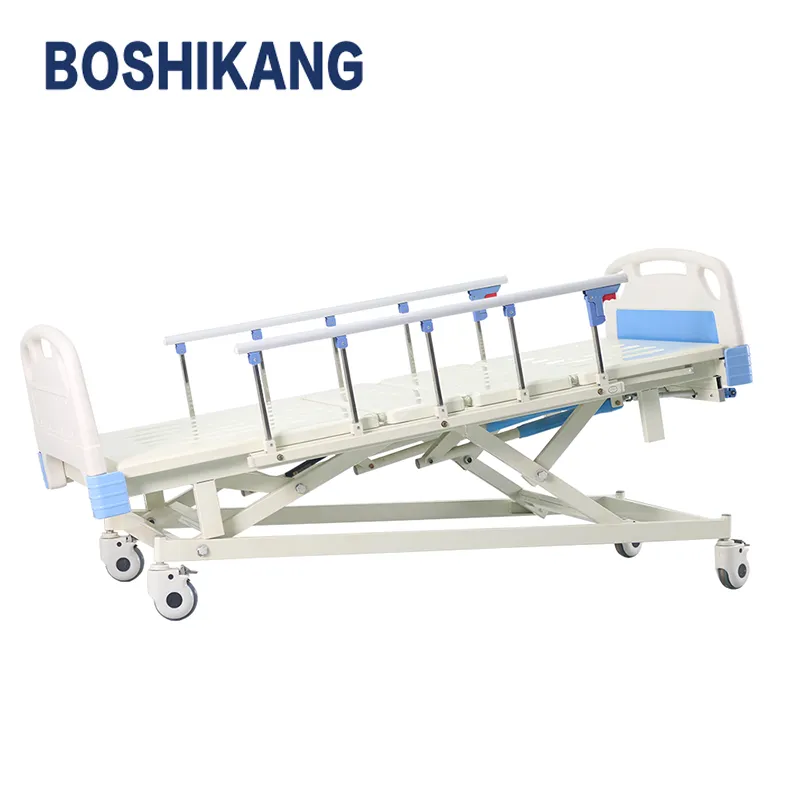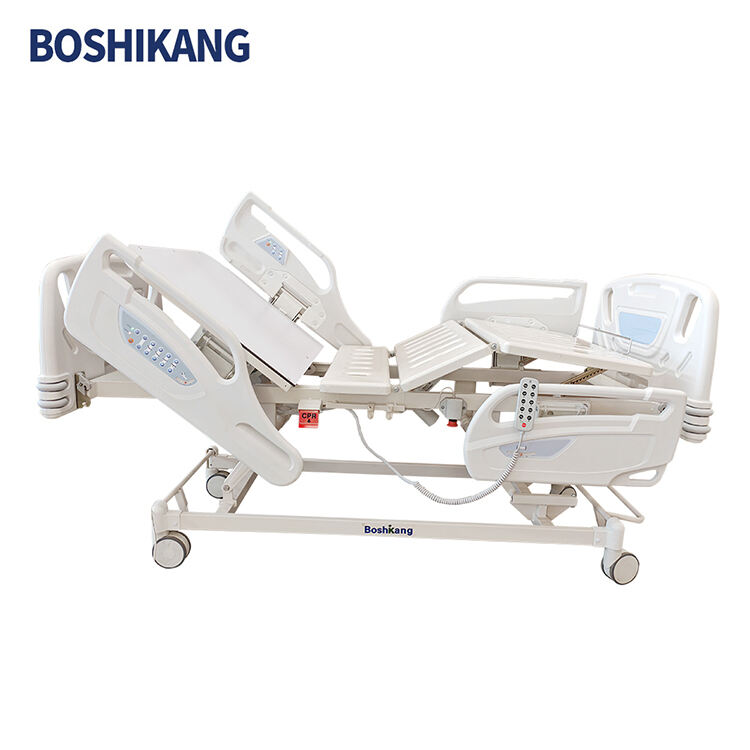The Evolution of Hospital Bed Technology
When hospitals started switching from manual to electric beds back in the day, it was pretty much a game changer for medical tech. Before this shift, nurses had to physically crank those old beds up and down all day long just to get patients comfortable. But things changed quite a bit over time as electric models became more common across facilities nationwide. What makes these newer beds so special? They've got built-in motors that let staff adjust positions with the push of a button rather than breaking their backs doing it manually. The American Hospital Association actually tracked this trend and found that more and more hospitals keep adopting electric beds year after year. Makes sense really when you think about how much easier life gets for both patients who need frequent repositioning and the caregivers looking after them.
Electric hospital beds are getting better all the time, with new features focused on making patients more comfortable and improving overall care results. Modern tech makes these beds work much smoother and lets caregivers position them exactly where needed, which helps prevent those nasty pressure sores and keeps blood flowing properly. Most models now come with adjustable heights and can automatically change positions based on what doctors recommend for specific conditions. For hospitals dealing with tight schedules and limited staff, this kind of tech isn't just nice to have it's becoming almost necessary. Clinics report faster turnaround times between patients when beds have these smart features built in, plus nurses spend less time manually adjusting equipment during rounds.
Reducing Physical Strain on Healthcare Staff
Automated Adjustments and Manual Lifting Reduction
Hospital bed automation is changing how care is delivered in medical facilities by cutting down on the need for staff to lift patients manually, which takes a real toll on their bodies over time. These modern beds come equipped with electric motors that handle adjustments to height, angle, and recline positions, making it much easier for nurses and aides to position patients without straining themselves. Research into workplace safety shows hospitals that have adopted these automated systems see fewer injury reports among staff who previously dealt with back problems from constant patient handling. When healthcare workers aren't constantly battling physical exhaustion from repetitive tasks, they tend to stay happier in their jobs, and this ultimately creates better conditions for everyone involved in patient care.
Ergonomic Design for Staff Well-Being
The way electric hospital beds are built ergonomically really matters for keeping healthcare workers healthy. Modern models come equipped with height adjustments, tilt functions, and control panels placed at convenient heights so medical personnel don't have to bend awkwardly or lift patients improperly. According to industry studies, hospitals that upgraded to ergonomic beds saw around a 30% drop in back injuries among nurses alone. When staff members aren't constantly battling physical discomfort from repetitive tasks, they naturally perform better at their jobs. This means cleaner patient interactions, faster response times during emergencies, and ultimately better outcomes across the board for everyone involved in care delivery.
Case Studies: Impact on Musculoskeletal Injuries
Looking at hospitals across the country shows electric beds really cut down on back injuries for nurses and other staff members. Take one medical center that switched to these beds last year. They kept track of worker injuries throughout the whole year and found around 30 fewer cases of muscle and joint pain complaints compared to previous years. Nurses who actually work with patients day in and day out report feeling less sore after shifts and getting things done faster when moving patients around. Many mention how much easier it is to adjust bed heights without straining their bodies. These improvements aren't just good for individual workers either they translate into better care for patients too since tired, injured staff simply can't perform at their best levels consistently.

Enhancing Patient Mobility and Care Delivery
Easier Repositioning for Recovery Protocols
Electric hospital beds really boost recovery efforts because they make it much easier to move patients around during different treatments. The automatic adjustment features let caregivers set the bed at just the right angle for whatever therapy is needed, which cuts down on all the backbreaking work of manually moving patients. Medical professionals point out that getting patients into proper positions at the right times makes a big difference in how fast they heal, keeps them more comfortable overall, and helps prevent problems such as bedsores that can develop when someone stays in one spot too long.
Customizable Positions for Targeted Therapies
Electric beds are pretty adaptable and really help with certain types of treatments, especially when it comes to things like breathing issues or broken bones. These hospital beds let staff adjust them at different angles and positions which makes a big difference in how well treatments work. Patients get a much better experience because everything fits their particular situation. There was this research looking at people recovering from bone injuries, and they found that changing bed positions actually cut down healing time and made folks feel more comfortable while going through their physical therapy.
Patient-Controlled Mobility Features
When electric hospital beds come with mobility features that let people adjust them themselves, it really makes a difference for patient autonomy and overall satisfaction. Patients can change positions whenever they want without needing help from staff, which builds their sense of independence and generally lifts their spirits too. Many patients who've used these beds report feeling better about themselves and recovering faster because they actually get to control aspects of their care. Their stories show just how much accessible tech matters in hospitals where everything feels so out of control at times.
Improving Workflow Efficiency in Healthcare Facilities
Time-Saving Adjustments for Nursing Staff
Electric hospital beds make life much easier for medical staff working in busy facilities. When nurses need to adjust bed heights or positions, they simply press buttons instead of struggling with manual cranks and levers. A recent study found that automated bed systems cut down adjustment time by around 30% according to Healthcare Technology Today's findings. The extra minutes saved each day might not seem like much individually, but over weeks and months adds up to hours that nurses can dedicate to actual patient interaction, administering medications properly, and responding faster when emergencies arise. Hospitals that have switched to these smart beds often notice improvements across their entire operation just from this one small change in daily routines.
Streamlining Patient Transfers and Admissions
Electric beds make it much easier to move patients around, particularly when they're being admitted or transferred between departments. The beds come with automatic steering features and can adjust to different positions, so moving folks from one place to another happens smoothly without putting extra strain on either the patients or the staff members handling them. Many nurses and doctors have noticed this already. Take Dr. Karen Smith for instance who works at City General Hospital. She says these beds cut down on the time needed for transfers while keeping everyone safer during the process. In hectic hospital environments where getting patients settled quickly matters a lot, having equipment that speeds things up makes all the difference in how efficiently the whole facility runs day after day.
Integration with Shift Scheduling Systems
When electric beds come with built-in tech features, they actually sync up pretty well with staff schedules, making things run smoother in hospitals. The connection between available beds and when nurses are on duty means patients don't sit around waiting so long when they check in or need to move rooms. Take St. Mary's Health Center for instance they saw about a 20 percent drop in waiting time after adding these bed management systems to their regular schedule stuff. Getting all this connected makes sure people get cared for at the right time, which naturally makes them happier. Plus, it helps hospitals make better use of their resources across different departments.
Enhancing Safety for Patients and Staff
Fall Prevention Through Height Adjustment
Electric hospital beds with adjustable height settings play a big role in keeping patients safe from falls. When caregivers can adjust the bed to just the right level, it makes transfers much safer and reduces the chances of someone falling while trying to get up. Research from The Joint Commission shows hospitals using these adjustable beds report fewer fall incidents overall. These modern beds come with extra safety features too. Many models now have alarm systems built right in that let nurses know immediately if a patient needs help getting up or moving around. Some facilities even tell stories about how these alarms catch potential problems before they become actual accidents.
Pressure Ulcer Risk Reduction Strategies
Modern electric hospital beds come with special features designed to prevent those painful pressure sores we all know too well. Many models now have these fancy pressure relief surfaces that actually work better than traditional ones. The beds also help keep air circulating underneath patients, which cuts down on moisture buildup and stops the skin from breaking down. Research from the Journal of Clinical Nursing showed hospitals using these electric beds saw fewer cases of pressure ulcers overall, especially when they had those computer controlled tilt functions. Getting patients moved around regularly is obviously important for their skin health, but it also saves money in the long run since treating pressure injuries can get really expensive for both patients and healthcare providers.
Safety Rails and Emergency Lock Features
Electric beds come equipped with safety rails and emergency locks which play a big role in keeping patients safe during their stay. These rails stop people from falling out of bed while they sleep or rest, giving them peace of mind throughout recovery. Many hospitals actually saw fewer incidents after installing these extra precautions. For instance, several medical centers reported better outcomes once they switched to beds with advanced locking systems. Having proper railings and secure locks around creates safer conditions not just for those recovering but also for nurses and other hospital workers who need to access the bed area without worrying about unexpected movements. This makes everyone's job easier and reduces risks across the board in clinical settings.
Integration with Medical Equipment and Technology
Connectivity with Vital Signs Monitoring
Modern electric hospital beds now come with built-in connections to vital sign monitors, which helps doctors keep an eye on patients all day long. When hooked up to EMR systems, these beds automatically send information about things like pulse rates and breathing rhythms straight into doctors' computers. Nurses don't have to manually enter so much data anymore. The connection between bed sensors and medical records makes it easier for staff to spot problems early on. According to recent reports from several hospitals across the country, when clinicians get instant updates from these smart beds, they catch potential issues faster and make fewer mistakes during treatment. For instance, one hospital saw a 30% drop in nighttime emergencies after installing this kind of system. These beds give caregivers a complete picture of what's going on with each patient, ultimately saving time and resources while keeping people healthier overall.
IoT-Enabled Beds for Data-Driven Care
Putting Internet of Things tech into hospital beds represents a major step forward for modern patient care. These smart beds gather all sorts of important health information - things like when patients move around, where their weight is distributed across the mattress, even details about their sleeping habits - and send it straight to nurses and doctors who need it most. The real value comes from being able to create custom treatment approaches based on what each individual actually needs, not just standard protocols. Research from several medical centers shows that hospitals using these connected systems see better results in managing chronic conditions and preventing complications. For hospital staff, these IoT features mean less time spent manually recording data and more time actually caring for patients. When someone starts showing signs of distress or discomfort, alerts go out immediately so help arrives faster than ever before.
Emergency Alert Systems and Staff Response
Electric beds with built-in emergency alert systems really make a difference when it comes to getting staff on scene faster during emergencies. When someone needs help right away, these systems instantly notify nurses through their pagers or smartphones, so they don't have to rely solely on traditional call buttons. Many hospitals report seeing real improvements after installing these systems. For instance, one facility noted that response times dropped by nearly 40% within six months of implementation. The ability to pinpoint exactly where patients are in trouble means fewer minutes wasted searching for them. Hospitals that adopt these technologies generally see better outcomes across the board. Not only do they handle crises more efficiently, but they also create an atmosphere where patients feel genuinely cared for, which is what modern healthcare should be all about.
Conclusion – Why Electric Beds are Essential for Improving Staff Efficiency and Patient Care
Electric hospital beds have become essential in today's hospitals because they really help improve how fast staff can work while also making patients more comfortable. These beds come with all sorts of adjustments that take some of the physical burden off nurses who would otherwise have to manually lift or reposition patients throughout the day. For patients, this means less discomfort during treatments and better sleep quality overall. What makes these beds even more valuable is their ability to connect with other hospital systems. Many models now send vital signs directly to monitoring stations so doctors get immediate alerts if something goes wrong. This kind of integration not only saves time but actually prevents emergencies from getting worse before anyone notices them. Hospitals report fewer accidents and faster response times since switching to electric beds across most departments.
FAQ Section
Why are electric hospital beds preferred over manual ones?
Electric hospital beds offer automated adjustments that provide enhanced comfort and precision for patients, and they reduce the physical strain on healthcare staff compared to manual beds.
What are the key features of modern electric hospital beds?
Modern electric beds feature adjustable height, remote control options, and the ability to reposition into various therapeutic and resting positions like Trendelenburg.
How do electric hospital beds enhance patient safety?
Electric hospital beds contribute to safety with features like fall prevention due to height adjustment, pressure ulcer risk reduction, and safety rails with emergency locks.
How do electric beds integrate with medical technology?
They integrate with vital signs monitoring systems, synchronize with electronic medical records, and some are IoT-enabled for real-time data-driven care.
Do electric hospital beds improve workflow efficiency?
Yes, they save time on bed adjustments, simplify patient transfers, and integrate with scheduling systems to improve hospital operations.
Table of Contents
- The Evolution of Hospital Bed Technology
- Reducing Physical Strain on Healthcare Staff
- Enhancing Patient Mobility and Care Delivery
- Improving Workflow Efficiency in Healthcare Facilities
- Enhancing Safety for Patients and Staff
- Integration with Medical Equipment and Technology
- Conclusion – Why Electric Beds are Essential for Improving Staff Efficiency and Patient Care
- FAQ Section


